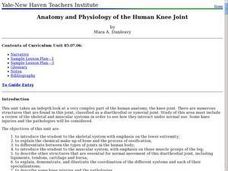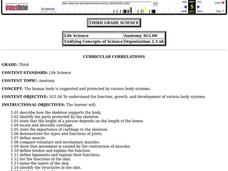Curated OER
Human Anatomy- How Do We Move?
Students examine the muscular system. In this muscular system lesson, students first draw a realistic representation of their leg or arm bones. Students do several activities to attach these bones to "joints" with string to simulate...
Curated OER
Life Science: Human Body Skit
Young scholars create skits based on the human body systems. Working in groups, they role-play as organs in the various systems. They make costumes or wear signs identifying themselves as the organs in their skits.
Curated OER
Human Anatomy - How Do We Move?
Fifth graders discover how blood moves around the body. In this circulatory system lesson, 5th graders feel their pulse before and after exercise. Students count their heart rate. Students use the scientific method to record...
Curated OER
Anatomy and Physiology of the Human Knee Joint
Students examine human anatomy with a focus on the knee joint. In groups, they research the chemical makeup of human bones and explain the different types of joints found in the body. To end the lesson, they identify the other structures...
Curated OER
Human Anatomy
Students use the web to explain how the bones serve as protection for organs in the body and recognize some of the bone structure that protect certain organs. They comprehend the different structure and functions of support tissue...
Curated OER
Natural Born Robots: Body Builders
Students perform activities to explore how their arm works and what muscles are involved. They view animated comparisons of human and robotic arms. Students create a model of the human arm.
Curated OER
Levers in the Body: They Are Not What You Might Think!
Students investigate lever systems in the human body and compare arm anatomy to model. In this human levers lesson students graph and analyze their results.
Curated OER
The Nervous System
Students investigate the nervous system. In this anatomy activity, students identify and define vocabulary related to the nervous system. Students role play the parts of a nervous system and perform an experiment measuring and...
Curated OER
Anatomy and Physiology "Quickies"
Students use a variety of creative writing tools within this assignment: poems on particular organ systems, write a short story and/or create a word graph. They are involved in a demonstration of lactic build up in the muscles, a...
Curated OER
21st Century Medicine: Nerves of Steel
Students model a sarcomere's action, they gain a kinesthetic and visual understanding of muscle contraction. They use this exercise stimulates the production of myosin and actin. Students use two colors of clay, make a "sandwich" of...
Curated OER
MuscleMania
Students learn three different types of muscles. By building a model of the arm, they learn its basic anatomy and how muscles function in relationship to bones. They perform an experiment on the relationship between muscle size and...
Curated OER
The Skeletal System
Students research the skeletal system. In this anatomy lesson, students measure their bodies to find the approximate length of their bones. They draw and cut out each of the bones and then attach them using brads or glue.
BioEd Online
The Skeleton
Don't be chicken to try a lesson plan that compares the anatomy of birds to humans. Read the background information so you don't have to wing it when it comes to the anatomy of a chicken. Prepare cooked chicken bones by soaking them in a...
Curated OER
Anatomy of the Heart
In this anatomy of the heart worksheet, students participate in a lab to describe the location of the heart in the body, identify a cardiac muscle tissue and trace the flow of blood through the heart.
Curated OER
Head, Shoulders, Knees and Toes
Students gain a greater comprehension of the anatomy and physiology of the muscular system, the skeletal system and connective tissue by researching joints in the body. They also reflect on the effects of injuries on their joints and...
Curated OER
Where is Your Heart? What Does it Do?
Students identify size and general location of human heart, identify heart muscle, describe, in general terms, heart's basic function of pumping blood throughout body, and complete "Where is Your Heart" and "What Does My Heart Look...
University of Minnesota
Homeostasis of Thermoregulation
Whether you're battling the flu or trying to warm up on a chilly day, your body's ability to react to temperature change is fascinating! Anatomy scholars discover the fantastic feedback loops that control body temperature in a rigorous...
Curated OER
Learning the Bones and Muscles of the Head and Face
Young scholars learn about the human body. In this science lesson plan, students discover the bones of the head and face as they explore their own cranium.
Curated OER
Movement, it's FUN-damental!
Students discover how muscles work. In this biology instructional activity, students explain the causes of fatigue and muscle soreness. They create graphs and compare results with their classmate.
Curated OER
Bones and Muscles
Third graders are introduced to bones as the body's means of support and protection. They research bone facts and conduct an experiment with chicken bones. They identify and observe involuntary muscles at work.
Curated OER
How Does Radon Affect Human Lungs?
Students identify the different parts of the respiratory system of the human body. They work together to complete an activity and worksheet about the effects of radon on the lungs. They research lung diseases if time permits.
Curated OER
Can You Name Parts of the Body?
Students share what they know about the human heart. In this early anatomy lesson, students discuss the location, shape, and importance of the human heart.
Curated OER
Examining and Discussing the Mechanics of Horse Evaluation
Via teacher-led discussion, agriculture classes discover the desirable characteristics of horse anatomy. The PowerPoint and worksheet mentioned in this plan are not available; however you may find the notes useful as a guide to the...
Curated OER
Skeletal System
Third graders describe and identify the parts of the skeleton and how they support the body. They observe two chicken bones that have been soaked in vinegar for 5 - 7 days. They observe the bone's appearance after it has been removed...

























